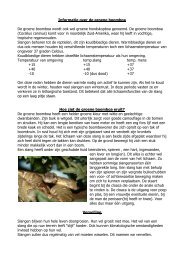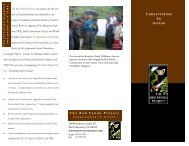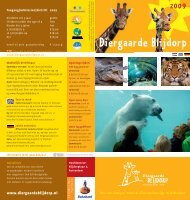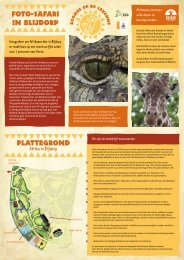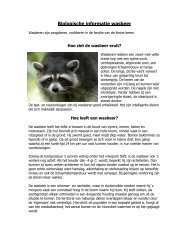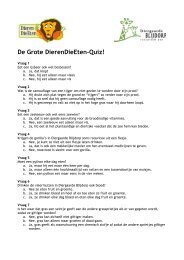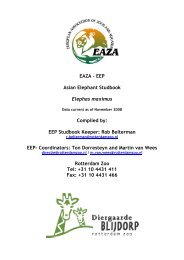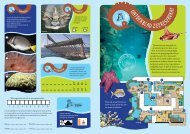You also want an ePaper? Increase the reach of your titles
YUMPU automatically turns print PDFs into web optimized ePapers that Google loves.
EUROPEAN STUDBOOK CROWNED PIGEONS<br />
Table 5.1 presents the diets of the five institutions with the best reproductive results compared with<br />
each other. The daily need for energy is 1.5 MJ metabolizable energy.<br />
Table 5.1: the diets of the five institutions with the best reproductive results compared with each other<br />
grams per MJ grams per day % dry matter<br />
Intake 250 40%<br />
Crude protein 10 15 15%<br />
Crude fat 7 11 11%<br />
Crude fibre 7 11 11%<br />
Crude ash 8 12 12%<br />
(Hallebeek, 1995)<br />
Comparison between crowned pigeon food in the wild and in captivity<br />
During a research project in Papua New Guinea by Marc Damen, samples were taken of the crop<br />
and stomach contents from four crowned pigeons. Table 5.2 shows a comparison between the<br />
results of the questionnaire and the results of the analysis of the samples from the wild crowned<br />
pigeons. The values of the wild-diet are derived from the samples taken from the crop, and not the<br />
stomach, because the contents of the stomach are already more digested than the food parts in the<br />
crop.<br />
Table 5.2: Comparison between crowned pigeon food in the wild and in captivity<br />
Zoo-diet Wild-diet<br />
(g/kg DM) (g/kg DM)<br />
Crude protein 150 ± 38 96 ± 12<br />
Crude fat 110 ± 16 102 ± 24<br />
Crude fibre 110 ± 21 449 ± 73<br />
Crude ash 120 ± 30<br />
Phosphorus 2 ± 8 1 ± 2<br />
Calcium 4 ± 17 2 ± 7<br />
There are some remarkable differences between the nutrition of crowned pigeons in the wild and in<br />
the five zoos with good reproductive results. The percentage of crude protein is much lower in the<br />
wild, which might be explained by the fact that these samples were collected shortly after the<br />
reproductive season. The same explanation might be applicable to the lower ratios of calcium and<br />
phosphorus in the wild. The ratio Ca/P is higher in the wild than in captivity. In zoos and bird<br />
parks, most crowned pigeons are able to produce eggs throughout the year (Hallebeek, 1995),<br />
while the samples in the wild were collected about three or four months after egg production. The<br />
most remarkable difference is the ratio of crude fibre, which is four times as high in the wild as in<br />
captivity. The food, collected from the crop and stomach of crowned pigeons in the wild, contains<br />
a lot of large seeds, while the food of crowned pigeons in captivity usually comprises of smaller<br />
food parts. The largest pieces they get in captivity are pies and parts of fruits, while in the wild<br />
they are swallowing whole beans (which are rich in fibre) up to 6 cm long. The large stones they<br />
swallow in the wild might assist to digest the large food parts faster (Vogel, 1984).<br />
It should be considered to supply the crowned pigeons in captivity with larger food parts, to<br />
stimulate the activities of their gastro-intestinal tract. If more crude fibre and large mineral stones<br />
should be fed to the birds, their gastro-intestinal tract would be more active, which will reduce<br />
stress and will lead to more natural behaviour. Furthermore the amount of protein, calcium and<br />
phosphorus is higher in captivity than in the wild, and this can be a reason for the relatively high<br />
egg production in captivity. Of course there are more factors which can have an influence on the<br />
breeding results like zootechnic factors and stress.<br />
165





